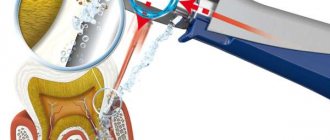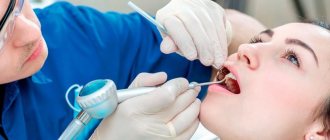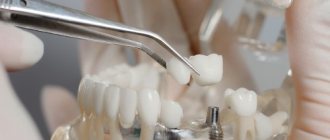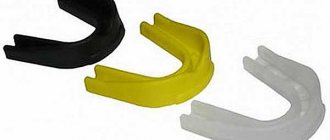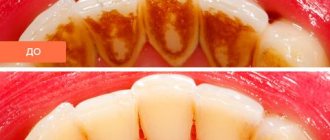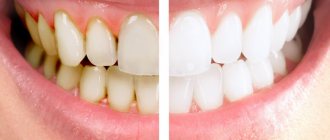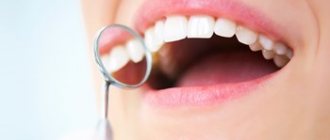Tartar not only disrupts the aesthetics of a smile, but leads to gum disease, bad breath, the development of dental caries and, in advanced cases, tooth loss.
Regular teeth cleaning using ultrasound removes hard plaque from the surface of the teeth and from shallow periodontal pockets (maximum up to 5 mm), the procedure is carried out using a special device - a dental scaler (scaler). The device can be built into a dental unit or stand-alone.
An ultrasonic scaler consists of a control unit and vibration generation unit, a handpiece, removable (replaceable) attachments and a control pedal. The device is equipped with a liquid supply system. During operation, the device creates ultrasonic vibrations with a frequency of 25-30 kHz, which are transmitted to the tip nozzle.
Physical principle of operation: an ultrasonic wave is transmitted from the tip to the scaler nozzle, which in turn transfers it to dental plaque. Under its influence, deposits are destroyed from the inside. To prevent damage to tooth enamel, the dentist moves the attachment strictly along the surface of the tooth. The simultaneous supply of water to the zone of ultrasound influence provokes the effect of cavitation, the formation of micro-bubbles in the volume, which accelerate the process of destruction of tartar. At the same time, water or a medicinal solution helps wash away dental plaque destroyed by ultrasound from the treatment area.
Benefits of ultrasonic teeth cleaning
The first devices for ultrasonic teeth cleaning, which appeared in the 60s of the last century, were somewhat imperfect, and after their use, damage to the enamel could occur. Therefore, plaque and tartar were often cleaned manually. Modern ultrasonic units are absolutely safe; they are used not only for removing tartar, but also for removing crowns, minimally invasive preparation of enamel areas affected by caries, and caring for dental implants.
The benefits of ultrasonic teeth cleaning include:
- Painless;
- Safe and complete removal of plaque in small periodontal pockets and on the surface of teeth;
- Impact exclusively on problem areas;
- The ability to regulate the strength of ultrasound;
- A variety of tips designed to work on different areas of the tooth surface;
- High hygiene of the procedure;
- Automatic adjustment of the system to the load;
- A quick and easy procedure that can be performed by a hygienist. Complex cases with deep periodontal pockets are not considered here;
- Affordable price.
Dental surgeries performed using ultrasound
Ultrasound treatment of teeth involves not only cleaning them from accumulations of soft and hard plaque, treating the canals, but also removing them. This area relates to piezosurgery, which allows complex surgical procedures to be performed by using waves of a certain length.
In dental practice, it is actively used if bone grafting or maxillofacial surgery is indicated, it is necessary to remove the destroyed base. Piezosurgery is the best alternative to standard forceps, drills and elevators.
Ultrasonic tooth extraction is carried out using a special piezosurgical unit. She is educated:
- workstation;
- a vessel for water;
- tips of different shapes and lengths.
The latter are very thin and easily penetrate even the most inaccessible areas of the mouth.
Indications for use
Almost every adult needs ultrasonic teeth cleaning to prevent the formation of dental plaque, but there are categories that are recommended to perform the procedure first:
- Patients preparing for caries treatment and teeth whitening, installation of implants, braces, dentures;
- Patients after removal of braces;
- Patients with installed implants, crowns (special plastic attachments are used for cleaning);
- Patients diagnosed with gingivitis or periodontitis.
When should you not undergo ultrasonic whitening?
The described technique has a number of contraindications. This means:
- the presence of braces or fixed plates;
- severe heart pathologies;
- bronchial asthma;
- untreated bronchitis, acute respiratory viral infections, acute respiratory infections;
- tuberculosis;
- HIV;
- hepatitis.
It is not recommended for schoolchildren and teenagers to undergo professional dental hygiene. It is also undesirable to resort to it during pregnancy (especially in the first twelve obstetric weeks).
Contraindications
Like any medical procedure, ultrasonic teeth cleaning has its contraindications:
- Installed pacemaker;
- Acute inflammatory processes in the periodontium, osteomyelitis;
- Oncological neoplasms in the oral cavity;
- Erosion of soft and hard tissues of the oral cavity;
- Severe form of diabetes mellitus;
- Acute and chronic infectious diseases;
- Severe diseases of the cardiovascular system;
- Epilepsy;
- A history of retinal surgery (consultation with an ophthalmologist is required).
Flaws
Despite these advantages, the procedure has disadvantages:
- when working with the device, it is possible to injure the soft tissues of the oral cavity, so the procedure should only be performed by a highly qualified specialist;
- in some cases it is impossible to remove the stone from all sides;
- For sensitive teeth, local anesthesia will be required.
In addition, ultrasonic teeth cleaning has a number of contraindications.
Note. Sometimes dental clinics use scalers, which, when rotated, can damage tooth enamel. Before you sign up for a procedure, check with the administrator what model of device the dentist will use. If the device is outdated, it is better not to take risks and abandon the procedure.
Methodology
Assuming that the medical history has been collected and the patient has been given all the necessary explanations, ultrasonic teeth cleaning is carried out in the following sequence:
- The patient sits in a chair, the doctor examines the oral cavity and determines the amount of work to be done. In case of increased tooth sensitivity, local anesthesia is performed, but usually the procedure is carried out without additional anesthesia;
- The doctor installs a mouth opener - a special device that helps the patient hold his mouth open for a long time (the cleaning procedure lasts about 30 minutes on average). Thanks to the mouth retractor, the dentist gets full and unobstructed access to the surface of the teeth;
- Dental plaque is removed with an ultrasonic scaler. The water that is supplied to the tooth surface during operation of the device, along with particles of tartar and saliva, is removed from the oral cavity using a saliva ejector. First, the visible part of the crowns is cleaned of soft deposits, then tartar along the gum border is removed, and finally, periodontal pockets are curetted;
- Upon completion of the plaque removal procedure, the doctor polishes the surface of the teeth with a special polishing paste, this makes the enamel smooth and prevents plaque from re-attaching;
- The next stage (performed if necessary) is the treatment of teeth with a fluoride-containing gel, which strengthens the enamel and restores its structure. The composition is also able to protect the enamel from external influences and reduce tooth sensitivity;
- If there is inflammation on the gums, they are treated with anti-inflammatory drugs. The patient continues to care for his gums at home using products recommended by the dentist: this can be rinsing or treating the gums with gels and solutions purchased at the pharmacy.
How a tooth is removed during ultrasound treatment
In fact, this technique is not so different from the classical one. The main difference is that during the operation the doctor uses ultrasonic tips rather than standard dental instruments.
Conventionally, the whole process can be divided into a number of stages:
Diagnostic measures. The doctor examines the patient's oral cavity and decides on surgery.- Submission of laboratory tests. It is necessary if a person has systemic diseases or increased body temperature.
- Delete. First, anesthesia is administered. When the anesthetic takes effect, they immediately proceed to the operation. As a result of the treatment of hard tissues with a wave, the gums are exfoliated from the roots. This allows them to be removed with minimal invasiveness and little blood loss.
- Processing the hole. Once the roots are removed, the surgical wound is washed with an antiseptic.
Healing with this method of tearing out occurs much faster, since ultrasonic exposure makes antiseptic and anti-inflammatory solutions more effective.
Comprehensive hygienic cleaning
For more effective cleaning of the dental surface, we recommend that our patients undergo comprehensive oral cleaning, which includes:
- Ultrasonic cleaning of teeth from tartar;
- Air Flow cleaning – removal of micro-roughness remaining on the enamel surface after removing tartar. Cleaning is carried out with a special abrasive mixture, which is supplied under high pressure. Also, with the help of Air Flow, pigment spots and “smoker’s plaque” are removed, the tooth surface becomes much lighter;
- Polishing the enamel surface with paste;
- Deep fluoridation of tooth enamel (if necessary).
If the patient, after comprehensive hygienic cleaning of the oral cavity, follows the rules for caring for the oral cavity, then he reduces the likelihood of re-formation of tartar, because prevents the hardening of soft dental deposits that inevitably accumulate on the surface of the teeth. Therefore, during the next preventive examination, teeth cleaning may be limited to using the Air Flow method to remove stained plaque.
For periodontal pockets deeper than 5 mm, it is recommended to undergo a procedure for removing hard deposits using a vector device.
What it is?
Professional teeth cleaning means removing hard and soft plaque from teeth, as well as polishing them. Therefore, the procedure usually consists of two parts, and various methods can be used to remove the stone, for example:
- mechanical;
- ultrasonic;
- laser:
- sandblasting (Air Flow);
- using the VECTOR device.
In serious cases, the dentist may use a combination of several methods. Most often, ultrasonic cleaning is done, and then for final polishing, Air Flow is used.
In addition to caring for your teeth, professional cleaning takes care of the condition of your fillings and polishes the filling material. This allows you to preserve the original color of the filling and prevent its destruction.
During the manipulation process, the dentist performs a hardware removal of all excess from the tooth enamel and removes particles from the oral cavity. At the end, a protective fluoride varnish is applied, which reduces tooth sensitivity and contributes to the long-term preservation of the light tone of the enamel and the smoothness of each tooth.
Caring for your teeth after ultrasonic cleaning
After the procedure, especially if a lot of plaque has been removed, there is a slightly increased sensitivity of the teeth to temperature and chemical irritants, so for 24 hours after cleaning, patients are advised to refrain from eating excessively hot, cold, sour and salty foods. It is advisable to follow a “white diet” for a couple of days, as after teeth whitening, to exclude strongly coloring foods from the diet (red wine, coffee, black tea, beets, some bright fruits and juices from them) so that the cleaned enamel does not absorb food dyes, and on the contrary, enrich it with solid and fiber-containing products that will prevent the appearance of plaque and stones (fruits, vegetables, nuts, etc.).
If sensitivity is severe, it is recommended to replace your regular toothbrush with a soft-bristled brush for several days and purchase toothpaste that reduces sensitivity.
After each meal, you need to rinse your mouth with clean water - this rule must be observed not only after ultrasonic cleaning, but also constantly.
On the first day or two, it is also recommended to brush your teeth after every meal.
What results can be achieved
Upon completion of the necessary dental procedures, the patient may notice that:
- His teeth became much whiter and acquired an even, uniform color.
The gray spots, which are an accumulation of pigment particles, disappeared without a trace. - There are no deposits along the gums.
- The tooth surface became perfectly smooth and even, pleasant to the touch.
- The interdental spaces have cleared, so it may even seem that they have increased. In fact, there are simply no more stones in them.
- Bad breath no longer appears.
Often after ultrasonic teeth whitening, the dentist notices tiny cavities that were previously closed. Then he immediately treats them.
The most frequently asked questions from patients about the procedure
How painful is it?
(click to expand) Ultrasound teeth cleaning is a painless procedure, but it may be accompanied by minor discomfort in the presence of subgingival dental deposits - to remove them you need to slightly disturb the gums. Patients with increased sensitivity of the enamel may also complain of pain. In such cases, the doctor will perform cleaning with maximum comfort for the patient, using local anesthesia.
Is ultrasonic cleaning whitening? (click to expand) No, whitening is a completely different procedure, it is carried out using special whitening compounds that are applied to the tooth. A slight lightening of the enamel is due to the fact that after ultrasonic cleaning, the surface of the teeth is polished; sometimes the difference in color is clearly visible.
Is it true that plaque appears on teeth faster after ultrasonic cleaning? (click to expand) No, that's not true. On the contrary, after ultrasonic cleaning followed by polishing the enamel, plaque appears more slowly. Maintaining oral hygiene helps prevent its occurrence: responsible brushing of teeth at least 2 times a day, rinsing the mouth after meals, choosing the right toothpaste. Smoking, excessive consumption of tea and coffee, and metabolic disorders in the body contribute to the rapid appearance of plaque.
Can cleaning damage the enamel? (click to expand) If the procedure is carried out correctly, damage to tooth enamel is excluded. After cleaning, weak and thin enamel is additionally strengthened with remineralizing gels, the enamel is actively saturated with microelements, and it becomes stronger.
What should I do if I have an acute inflammatory process on my gums? (click to expand) Acute inflammation of the gums, accompanied by bleeding, in most cases is a contraindication to ultrasonic teeth cleaning until acute symptoms are relieved. We offer our patients tartar removal simultaneously with gum treatment using the Vector device. This is a specially designed ultrasonic scaler that is equipped with a unique Paro tip that creates special ultrasonic vibrations. The device allows for deeper treatment of periodontal pockets if the patient is diagnosed with periodontitis; Simultaneously with the removal of dental plaque, the enamel is polished with a special polishing liquid. After its use, supragingival and subgingival deposits, inflammation of soft tissues and bleeding are completely eliminated, bad breath disappears, and oral health is restored.
Is the procedure allowed during pregnancy? (click to expand) Ultrasonic teeth cleaning is not only allowed for pregnant women, but is also recommended for mandatory use. This is explained by the frequent occurrence of problems with teeth and gums in pregnant women due to hormonal changes and the need to sanitize the oral cavity before childbirth. The procedure is completely safe for the health of the expectant mother and her baby, but you still need to consult a gynecologist before performing it.
How often should you resort to ultrasonic teeth cleaning? (click to expand) We recommend that our patients have their teeth cleaned with ultrasound every 6-12 months; sometimes, if there is an increased tendency to form plaque, cleaning is done more often. The best solution is to carry out a comprehensive oral hygiene cleaning, which helps maintain oral health and fresh breath.
Ultrasonic teeth cleaning helps prevent the development of many dental diseases, so do not neglect this procedure.
In what cases should you use this type of cleaning?
The presence of tartar and complex plaque on the teeth is a contraindication for prosthetics. Therefore, before serious treatment, the dentist will definitely recommend undergoing an ultrasonic cleaning procedure. This helps prevent complications and speeds up the treatment of periodontal disease and caries. Cleaning the tooth cavity improves the quality of the filling procedure. Using ultrasonic cleaning, you can rinse periodontal pockets and clean the canals before treatment. This procedure reduces the risk of infection after tooth extraction.
Most patients learned about the effectiveness of ultrasonic cleaning in such cases. But those who care about oral health do it regularly. In many cases, ultrasonic cleaning is carried out in conjunction with other procedures, such as teeth whitening and polishing, fluoridation and protective film coating. Often after this, the dentist prescribes special treatment to relieve gum inflammation.
Cost of ultrasonic teeth cleaning
One of the first questions that patients are interested in is how much does ultrasonic teeth cleaning cost? This procedure is one of the most affordable in dentistry, its cost depends on the individual characteristics of the body, in particular, in some people, tartar is almost completely dissolved by saliva, in some people periodontal pockets do not form, or the opposite example, in the presence of severe curvature of the teeth, Hard plaque forms so heavily that it will take an hour or more to thoroughly remove it.
In our clinic, the cost of ultrasonic teeth cleaning is fixed and unchanged. For complex cases, our clear recommendation is to use the vector device.
Prices for ultrasonic teeth cleaning in Dental World dentistry.
Cleaning methods
Currently, dentists offer several methods for cleaning teeth. The oldest is mechanical, when tartar is destroyed using a special tool in the form of hooks. This method can injure your gums, so it is rarely used.
One of the progressive methods is ultrasound. Cleansing is carried out using an ultrasonic scaler. Stones are destroyed by sound vibrations of a certain frequency, while plaque is removed and supragingival and subgingival pockets are cleaned. The doctor can use attachments of different sizes, depending on the complexity of the treatment area and the thickness of the plaque. In addition, during the work, water or an antiseptic is supplied to the oral cavity, which removes stone particles through a dental saliva ejector. The patient does not feel pain, but if the necks of the teeth are sensitive, the doctor administers local anesthesia.
Modern laser systems allow not only to remove the hardest tartar, but also to whiten teeth. The device causes the evaporation of moisture contained in plaque and removes deposits from the enamel in layers. At the same time, the enamel receives a lighter shade, and the achieved result of a snow-white smile will last for several years. The procedure is absolutely painless, but for certain categories of patients there are contraindications.
The latest Swiss technology Air Flow makes it possible to remove particles of plaque, stone and pigments in hard-to-reach places, clean subgingival pockets and polish enamel. Treatment is carried out with a jet of cleaning mixture, which consists of sodium bicarbonate and water. Under high pressure, this composition is applied to each tooth. Regular baking soda acts as an abrasive. This sandblasting method allows for high-quality hygienic treatment, removing all excess from the teeth, achieving a smooth surface of the tooth enamel and its natural lightening. The manipulation is painless and pleasant for the patient. The result is a Hollywood smile and clean teeth.
The VECTOR device is the latest word in dentistry. It is intended for the prevention and treatment of periodontitis and acts by vibration. This technique takes advantage of ultrasonic waves and the active action of a fluoride and calcium based cleaning mixture. Using such equipment, the doctor removes deposits and bacteria, cleans subgingival pockets and polishes tooth enamel.
Modern people have a wide choice of professional hygiene methods. A consultation with a dentist will help you choose the most suitable one.
What is tartar and what are the causes of its appearance?
Tartar is hardened plaque that forms on the visible part of the tooth (crown) and under the gum.
The reasons for its appearance are natural, but the consequences can cause pathologies in the oral cavity.
Initially, food particles stick to the enamel. Bacteria begin to actively multiply in them. A dental plaque is formed, which looks like a soft, light plaque. Plaque can be easily removed by regular tooth brushing. But if this does not happen, then food debris, dead cells of the mucous membrane, calcium and phosphorus salts from saliva are layered on the soft plaque. They crystallize and harden.
Mineralization occurs on average within 12 days. Soft plaque turns into hard plaque. Tartar has a rough surface, onto which more and more elements “cling.”
Attention: A bacterial film on teeth forms within 16 hours. Therefore, it is important to brush your teeth at least twice a day.
Photo of plaque, male jaw
Why hard deposits form
Plaque formation is inevitable, but there are a number of factors that accelerate the process:
- Irregular hygiene. Particularly active formation of plaque and stone occurs at night: salivation decreases, a person swallows less often, and does not move the tongue. This creates a favorable environment for bacterial growth.
- Poor hygiene. Brushing teeth with horizontal movements does not affect hard-to-reach areas. The interdental spaces should be cleaned by moving the brush vertically.
- Diet. A large amount of sweet and starchy foods leads to the sticking of carbohydrates to the enamel and the proliferation of pathogenic microflora. To reduce the rate of plaque formation, you should eat fresh, firm vegetables and fruits. Chewing the fibrous pulp for a long time partially helps remove plaque.
- Physiological features. Incorrect bite and crowded teeth make proper cleaning difficult.
- Metabolic disorders. The composition of saliva changes, its bactericidal properties decrease.
- Smoking. Cigarette tar settles on the teeth, causing the formation of films and plaques.
Pros and cons of ultrasonic tartar removal
Unlike other methods, ultrasonic cleaning has a number of advantages:
- Removes subgingival calculus that is difficult to reach with traditional instruments. To clean the root zone, the doctor pulls back the gums and works with the neck and root of the tooth.
- Cleans the interdental spaces even of very dense teeth, uneven, overlapping one another.
- The procedure does not last long - 40-60 minutes.
- Painless. The patient does not feel any impact.
- Non-contact influence. Only air and water come into contact with teeth. With the outdated mechanical method, the instruments scratch the enamel and cause an unpleasant “grinding” sensation.


